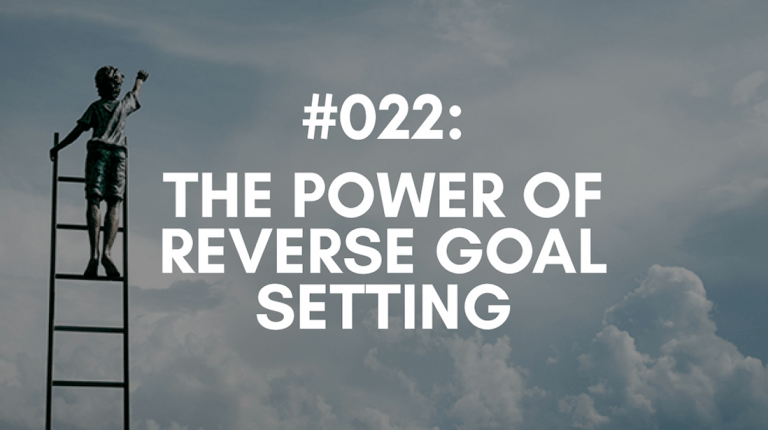Ep #227: The Metrics that Should Define Your Referrals
What’s Coming Up:
Are you joining me in December in the heart of Charlotte for my special Re:Focus Retreat? I’ll be walking you through my Reverse Goal Setting methodology and because we’re keeping the group small, you and I will be chatting about your goals specifically!! That’s right, this is an intimate event – not a ballroom full of people. Just you, me, and a few other amazing business owners and sales professionals ready to give 2023 the fighting chance it deserves. Find all details here.
*For GBR students – your special invite is in your inbox for the Re:Focus Retreat including details on adding on the special half day on Dec. 4th where we will set your #2023 Referral Plan together.
If you’re not a GBR student and want to be, you can join the self-study, online program here!
Now For the Episode:
Tracking isn’t the most exciting thing to do. It does, however, reveal some amazing data to help you better your business. It shows progress and decisions, including the outcomes of those decisions.
As we continue into Q4, it’s more important than ever that you have the right metrics when it comes to referrals. With the right metrics, you will feel informed on what type of decisions you need to make about what referrals will look like for you in 2023.
The three big ones you should be paying attention to are:
- The number of referrals you’ve received.
- The number of referrals that convert to clients.
- The number of referrals that you’re receiving from each of your referral sources.
So, that’s exactly what we will be discussing today!
Links Mentioned During the Episode:
To go along with this episode, also check out Episode #204 with my interview with Pineapple Jack on big-picture metrics for your business.
Looking for Referral Resources:
Take the Referral Ninja Quiz to test your skills and abilities at generating referrals. (FREE)
Buy my book – Generating Business Referrals Without Asking – and learn how to generate referrals through my 5 steps. (LESS THAN $16)
Check out our free resources on our Freebie Page. We have broken the free resources into two sections, based on if you’re less than 2 years in business or more than 2 years in business. Enjoy!
Consider joining Building a Referable Business™ – a unique way to learn all of my referral strategies and tactics with ongoing weekly access to me to answer your questions and help hold you accountable! Check it out and submit your application today!
Coming Up:
Next episode is #228, and we’re diving into how slow and steady wins the referral race.
Download The Full Episode Transcript
Read the Transcript Below:
Stacey Brown Randall: Metrics, metrics, metrics; love them or loathe them, you need them. And in today’s episode, we’re diving into the metrics that should define your referrals.
Hey there, and welcome to episode 227 of the Roadmap To Grow Your Business Podcast, a show about helping you build a referable business. I’m your host, Stacey Brown Randall.
Are you joining me in December, in the heart of Charlotte, for my special Re:Focus Retreat? I’ll be walking you through my reverse goal-setting methodology. And because we’re keeping the group small, you and I will be chatting about your goals specifically. That’s right.
This is an intimate event, not a ballroom full of people; just you, me and a few other amazing business owners and sales professionals, ready to give 2023 the fighting chance it deserves.
You can find all the details at staceybrownrandall.com/goals. That’s staceybrownrandall.com/goals. And Stacy has an E.
I cannot wait to see some of you there.
Metrics, metrics, metrics. So sexy, right? Well, you should think so. I know everybody doesn’t, but you should.
To be honest, I don’t really actually necessarily love tracking all the things that we need to be tracking as business owners, because actually, you have to slow down to track them. And I think sometimes, that’s where I’m like, that’s the rub with me, is that I got to slow down to track it, so that when I look back, I actually have data to look at.
But I do absolutely love what the tracking reveals to me about decisions I’ve made, progress I’ve made, maybe progress I haven’t made, when things didn’t go the way I thought they would. I love what the tracking reveals, because it shows progress and it shows decisions and the outcome of those decisions.
So, we are well into the fourth quarter of this year, and I want to make sure you’re good with the right metrics when it comes to referrals.
So, whether you use these metrics I’m about to give you and you apply them to this year, to 2022, or you just make the commitment to track this information starting at this point forward, moving into the last few months of 2022, or you promise me you’ll start 2023, in this way, don’t make it a New Year’s resolution. You’ll forget by February. Make it a commitment that you will track your referrals with these types of metrics at a minimum, in 2023.
But really, I’d love for you to apply this to what’s happened so far in 2022, or at least, let’s start from now forward and spend the last couple of months of the year focused on these metrics.
But you need to be tracking the right metrics when it comes to referrals so that you feel informed of what type of decisions you need to make about what referrals will look like for you in 2023.
This episode of course, reminds me of the episode we did, episode 204, when I did an interview with Pineapple Jack. For those of you who may remember that episode, that is his nickname, obviously that is not his real name.
Jack is actually one of my Growth By Referral students. He’s in the online self-study program. And he has a like tracking metrics database building company for small business owners.
And so, he came on the podcast to talk about like overall, the metrics that we should be tracking and what that looks like and what you need and what you don’t need and how to decide what you need from like an overall health of your business.
And it just reminds me of that, because we had the same conversation about love them or loathe them when it comes to metrics. And we looked at that from a totality of your business. So, if you want to go check out that episode, please do. That’s episode 204 and we’ll link to it in the show notes page.
But this episode, I’m specifically digging in to just the referrals piece. So, let’s talk about those referral metrics. There are really three big ones that I want you to pay attention to, and you can track these as simply as in an Excel spreadsheet or in your client relationship management software, some type of CRM, if you use that.
Or if you use some type of cloud-based software, sometimes it’s helpful for folks to use it to track this information. I don’t care if you pull out a legal pad of paper and you write down this information. It doesn’t matter to me.
I think it has to do with how much will determine how is the best way for you to track like how much stuff are we tracking here? You may decide you need to do this on the computer versus just doing it on piece of paper.
But there are three big referral metrics that I want you to pay attention to, that I want you to be able for your sake to say, “Hey, these were my metrics for 2022.” And if you’re coming to see me at that Re:Focus Retreat in December, I want you to be able to say, “Hey, this is what referrals looked like for me so far this year.”
The year won’t be over when you’re with me in Charlotte, in December, but I want you to be like, “Hey, this is what it looked like so far, and here’s how I’m projecting moving forward.” I think that’s super important for you to consider.
So, what are these three big metrics that I want you tracking on a day-end or week-end or month-end basis? Well, let’s dig into each of them.
Number one, this should really go without saying, in all honesty, but I’m going to say it anyways because it is one of the most important metrics you can track, and it’s the one that I tell my clients you have to track or what’s the point? And that’s the number of referrals received.
Obviously, when someone comes into one of my programs, whether they’re in my group coaching program, which is Building a Referable Business, or they’re just in the self-study online program, Referring Machines or Growth By Referrals, there is like a section on tracking. Like how do you track what’s happening because that’s the only way you can tell me it’s working or it’s not working. And then we can lean into what’s working and tweak maybe what’s not working.
So, of course, you need to be tracking the referrals as you receive them. A lot of people make the mistake of tracking it only to the point where if that referred prospect turns into a client and then they’ll track that referred client only along with the referral source.
But that means you are leaving a ton of important data like off the mark, like you are leaving a lot of data out of what you need to be paying attention to. You should track referrals at the moment they are received, not what is based on the outcome.
So, it doesn’t matter if you had a referred prospect sent to you and they closed or not. When it comes to tracking, you’re going to track it from the point it is received.
Now, okay, whether or not it closes is important, and that’s coming up in a minute, but for right now, the number one metric you need to be tracking when it comes to referrals, is the number of referred prospects received.
And by definition, a referred prospect is somebody who has been referred to you, who is considering working with you, who is an email that you received where they were connected to you by a referral source.
And in that way, from that perspective, we track it, from that point, whether they become a paying client or not. That’s relevant in a little bit, but not at the very beginning.
So, please make sure that you are tracking the number of referrals received from the moment they arrive. And I shouldn’t have to say this for my long-time listeners or my clients and students, please make sure you’re sending a handwritten thank you note every time you do receive a referral.
Yep, that would be awesome. Should go without saying. You’d be surprised that people have to be reminded to take two minutes and sit down and write a thank you note when somebody sends them a potential new client referred to them.
So, track that referral from the moment they arrive. So, that’s metric number one, number of referrals received. Easiest way I think to track this is track the date you received it, the name of the prospect who you hope will become the client, and the referral source who referred that prospect to you.
The second metric that I want you definitely tracking, is the number of those referrals received that actually do convert to paying clients. Those that do convert to clients.
So, when you’re tracking not only, “Hey, I received 30 referrals last year.” And then you know that you converted 15 of them into paying clients, that gives you your closing ratio, “Oh, so I have a 50% closing ratio. If I received 30 referrals, 15 of them said yes to becoming a client, and there’s nobody else left in process. Nobody else who’s still deciding to work with me or not. That means I have a 50% in terms of my closing ratio.”
Why the closing ratio is important for you to pay attention to, is because it’s actually an easier metric to be approved upon. If you’re being referred the right type of clients that you can work with and your closing ratio is low, like it’s in the tens or twenties or thirties or forties, it’s not over that 50% mark or it’s not over that 75% mark …
Sometimes when I’m working with clients in inside Building a Referral Business, I’m like, “Hey, you know what? You may not need more than 30 referrals in a year, but you’ve got to close more than 15 of them. We got to get you closing 20 or 25 of them,” if that’s what they’re looking for from a growth trajectory. Or that’s what they’re looking for and that’s what they can handle from a capacity perspective.
So, it’s important that we track not only the number of referrals that were received, but the outcome. Did they become a paying client? Did they decide to go elsewhere? Were they not a fit to begin with? That is also important.
But if you’re tracking the number that convert to clients, you’re automatically going to be able to use the formula of figuring out what your closing ratio is. And it’s typically the number of referrals received divided by the number of those that actually turn into a paying client, that’s going to get your closing ratio.
So, in our example, 30 referrals, 15 closed, that’s a 50% closing ratio of our 30 referrals, and that’s always something to pay attention to about improving. So, so important.
I have a client who is inside Building a Referable Business, been with me a couple years now, and every time we have a conversation, he goes like, “I’ve got my piece of paper.” He shows it to me every time, he pulls it off, he’s right next to his computer, and he shows me a very one specific question that I taught him to ask to every single referred prospect that is sent to him.
He grabs that piece of paper and he goes like, “I still say it all the time,” and it’s why his closing ratio has significantly increased, in an industry like his that is crazy, highly competitive.
And it’s because he has a strategy, like a tool. Just a small tool in place that he pulls out of his toolbox when he needs it, that helps him convert more referred prospects into paying clients and it’s because he knows what to do.
So, that is an easy thing that we can improve. If you’re getting a bunch of referrals and you’re not closing as many as you want and they are the right fit, then that is an easy strategy to improve upon. So, it’s something for you to consider. That’s the second metric I want you tracking.
And the third metric I want you tracking is actually the number of referrals that you’re receiving from each of your referral sources. So, this does a couple of things. The big thing is, is it’s going to give you the closing ratio by source.
So, if Sarah refers to you 10 prospects and Mike refers to you five prospects, you would then be able to calculate based on how many of Sarah’s 10 referred prospects turned into clients or Mike’s five turned into clients. You’d also be able to determine how well do you do at closing the prospects that Sarah sends you or Mike sends you.
So, for example, using this example of a fictitious Sarah; if Sarah sends you 10 referrals in a year, and maybe that feels crazy to you, you’re like, “I’m happy to get one from my referral sources.” That’s great. I’m just using round numbers because you guys know I hate public math. So, 10 is actually easier for me to figure out percentages than like two or three is.
So, Sarah sends you 10 referrals. 10 referred prospects in a year, and you closed six of them and four of them you did not. That means you’re closing ratio by Sarah, A.K.A. referral source is actually 60%. Which is maybe Mike refers you five people and you close none of them, which means you’re closing ratio by Mike is 0%.
Now, why this is important, is because that gives you insight based into how many you’re receiving and how well you’re closing them by individual referral source – it does give you insight into the quality of referrals you are receiving by individual referral source.
It also gives you insight and is helpful when you’re handling the levels for when your referral sources increase.
So, if you have like half a dozen or a dozen or maybe like 15 referral sources, you probably don’t have levels. Like I don’t actually start telling my clients when they work with me, “Hey, you need levels for your referral sources based on how many referrals they give you on average in a year. You need levels.”
They’re usually tipping over 20 to 25 referral sources. They’re definitely in the 30, 40, 50 range. When we’re like, “Okay, now we need to level these out, like a gold, silver, bronze kind of a thing.”
Because we have to manage it better. We have to have some different processes in place to manage it. It just looks different when 50 people are referring you versus 10 people are referring you.
So, if you know the number of referrals received from each referral source, which gives your closing ratio by individual referral source by each human, then you can understand the quality that you’re getting, and then how to handle the levels within your referral sources.
So, it’s like where to put people in different levels. It could be based on the number of referrals that they receive, or it could be based on the quality of what they of what they send you, or it could also be based on your closing ratio and all that matters.
The other piece that this gives you insight is like where to lean in, to the potential for more or better referrals from your existing referral sources.
Now, all this probably makes perfect sense to you, in terms of this is how you’re going to track it. The action of tracking it is actually what I’m not sitting there next to you on Monday morning, having you do. You’re going to have to build in a mechanism into your business to remind you or make it someone’s job to actually, track this information.
If you’re tracking the referrals received upon intake of that new prospect, that is now part of your buyer’s journey, this will make everything else easier because then it’s just a look back.
It’s like, “Hey, in this month, here’s the prospects that were referred to us and here’s what’s happened.” And then you can figure out all the other metrics. Oh, then we can figure out like how many did we receive and how many converted the clients? And that gives us our closing ratio, and how many came from Sarah and how many came from Mike?
All those things are really easy to figure out as long as you’re starting with the first metric that you have to track, which is the number of referrals received, and by whom.
But like I said, this makes perfect sense. This does not sound complicated, because it is not. But is still an action you’re going to have to take or process you’re going to have to put into practice inside your business. And that’s really, really important. Something that a lot of people will just overlook, because it’s easy to overlook it and you shouldn’t. You really, really shouldn’t.
Because when I’m digging in with my clients, with the business owners that I work with inside Building a Referable Business, when they come to me and they say, “Hey, I’m having this issue,” the very first thing I do is “Show me your data. What am I looking at?”
Because, because I’ve been doing this for so long, I can quickly see patterns and identify areas that we need to show up or make better, or things that you may be hanging on too tight to when you need to relax a little. I can see them in an instant.
That’s what I’m supposed to do. That’s why my clients pay me. Like that’s my job. Is to be able to see what they’re experiencing and ask the right questions to get to a place of what’s actually happening and then create a frame of attack. A frame of reference and a frame of forward movement and action plan to handle that problem.
Nothing gives me greater joy than when I have a client say to me, “Yep, you told me what to do and I did it. And guess what? It worked.” It always comes down to whether or not they did it though.
So, what I’m encouraging you to do is to definitely consider tracking your referrals received. Apply this to all of 2022, and keep it going in 2023.
Again, those three referral metrics I want you to track; the number of referrals received, even the date they’re received, and by whom you were referred to, that referral’s source and the prospect’s name.
Second, the number of those referrals that convert into paying clients. And third, the number of referrals received from each referral source.
Now, if you have questions about this, what’s the best way for you to track it? What are you already doing? Maybe you just want to like run a scenario by me. Maybe you have questions about what this would look like for you, or you want to make sure you’re capturing people with the right labeling – if you got any questions, I would love it if you would hop into our free community over on Facebook. It’s the Facebook group, Referrals Without Asking.
Yes, I recognize that means you need to be on Facebook, to be a part of that group. But I would love for you to join it and ask your questions.
Maybe LinkedIn groups will make a comeback and I can have a LinkedIn group with those of you who are on LinkedIn and not on Facebook, it’d be an easier place for you to go and ask your questions.
But I would love for you to share any questions you have or any thoughts or any aha moments you have, when you go back through and you start applying these three main metrics to your referrals.
And of course, all links mentioned will be on our show notes page, staceybrownrandall.com/227.
Quick reminder though, before I let you go; if you are a member of my Growth By Referrals self-study online program, and you want to work with me live and in person on your 2023 referral plan, that’s your plan for how you’ll take care of your existing referral sources. Go check your inbox for details, my friend, on our Re:Focus Retreat. You get a two for one special. The retreat is part all things referrals and part reverse goal-setting.
And if you’re not a member of My Growth By Referrals Program, but you still want to learn my reverse goal-setting process and hang out with me in December, then join me. Sign up now and reserve your seat for the Re:Focus Retreat at staceybrownrandall.com/goals. That’s staceybrownrandall.com/goals.
Okay, and before I sign off, if you haven’t yet left a rating or review, preferably five star, of this podcast, would you please take a moment to leave one on whatever is your favorite listening app for podcast.
When you do, when a show has more ratings and reviews, and when you do take the time to leave a rating and review, it certainly helps me reach more business owners who are just like you. So, thank you in advance, so very much.
Okay, next week is episode 228, and we’re diving into how slow and steady wins the referral race. Until then, take control and grow your business. Bye for now.
Thanks for listening to the Roadmap to Grow Your Business podcast. To
access all resources and links mentioned in today’s show, and to
connect with Stacey, head over to www.staceybrownrandall.com.







